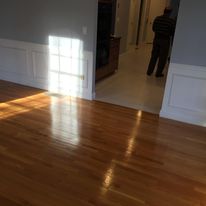In today’s environmentally conscious world, homeowners are increasingly seeking sustainable alternatives in every aspect of their living spaces—from energy-efficient appliances to eco-friendly materials. One of the most significant areas where sustainability makes an impact is flooring. Choosing eco-friendly flooring solutions not only supports a healthier planet but also promotes better indoor air quality and long-term durability. Whether you’re renovating your space or building from scratch, exploring green flooring options can transform your home into a stylish and sustainable sanctuary.
Why Choose Eco-Friendly Flooring?
Before diving into specific materials, it’s important to understand why eco-friendly flooring is an essential component of sustainable home design. Here’s what makes it stand out:
- Renewable Materials: Eco-friendly floors are typically made from renewable resources like bamboo, cork, and sustainably harvested wood.
- Low VOC Emissions: They contain fewer volatile organic compounds (VOCs), improving indoor air quality.
- Recyclable & Biodegradable: Many green flooring options are recyclable or biodegradable at the end of their lifecycle.
- Energy Efficient Production: Sustainable flooring materials often require less energy to produce compared to traditional flooring.
\Now, let’s explore some of the most popular and effective eco-friendly flooring solutions for modern homes.
1. Bamboo Flooring
Sustainability Factor: High
Bamboo is a fast-growing grass that regenerates quickly without the need for pesticides or herbicides. It can reach maturity in just 3–5 years, making it an excellent renewable resource. Bamboo flooring mimics the appearance of hardwood but with a much lower environmental footprint.
Advantages:
- Durable and strong
- Stylish and modern appearance
- Naturally resistant to moisture and insects
Considerations:
Look for FSC-certified bamboo to ensure it was harvested sustainably. Also, check for formaldehyde-free adhesives.
2. Cork Flooring
Sustainability Factor: Very High
Cork is harvested from the bark of the cork oak tree without cutting the tree down, allowing it to continue growing. This makes it one of the most sustainable flooring materials available.
Advantages:
- Naturally antimicrobial and hypoallergenic
- Provides excellent insulation (thermal and acoustic)
- Soft and comfortable underfoot
Considerations:
Cork can be sensitive to moisture, so it’s best used in low-humidity areas unless properly sealed.
3. Reclaimed Wood Flooring
Sustainability Factor: Excellent
Rather than harvesting new trees, reclaimed wood is salvaged from old buildings, barns, and factories. This gives the wood a second life while preserving its rich character and history.
Advantages:
- Unique, rustic appearance
- Reduces deforestation and landfill waste
- Extremely durable if properly treated
Considerations:
Ensure the wood is treated for pests and lead paint if sourced from older buildings.
4. Linoleum (Not to Be Confused with Vinyl)
Sustainability Factor: High
True linoleum is made from natural materials like linseed oil, cork dust, wood flour, and jute. It is biodegradable and has been used for over a century as a resilient flooring option.
Advantages:
- Naturally antimicrobial
- Durable and long-lasting
- Available in a wide range of colors and patterns
Considerations:
Avoid confusing it with vinyl, which is a synthetic product made from petroleum-based materials.
5. Recycled Materials (Rubber, Glass, Metal)
Sustainability Factor: Variable but Often High
Recycled flooring options include tiles made from post-consumer glass, rubber from recycled tires, and even metal scraps. These materials reduce landfill waste and offer a unique design aesthetic.
Advantages:
- Highly durable
- Unique and modern appearance
- Often resistant to water and stains
Considerations:
Ensure the product is certified as non-toxic and low in VOC emissions.
6. Sustainable Hardwood
Sustainability Factor: Moderate to High (Depending on Source)
While hardwood is a natural material, its sustainability largely depends on how it’s sourced. Look for FSC-certified hardwood, which ensures responsible forestry practices.
Advantages:
- Timeless beauty and appeal
- Can be sanded and refinished multiple times
- Adds value to your home
Considerations:
Avoid exotic hardwoods unless you can verify sustainable sourcing.
7. Concrete Flooring
Sustainability Factor: High (When Done Right)
Polished concrete floors can be surprisingly eco-friendly, especially when the concrete slab already exists (e.g., in basements or ground floors). Instead of covering it with other materials, simply polishing it creates a durable and stylish surface.
Advantages:
- Very durable and low-maintenance
- Excellent thermal mass for energy efficiency
- Customizable finishes
Considerations:
Concrete production can be energy-intensive, so using existing slabs or incorporating fly ash and other recycled materials improves its eco-credibility.
Tips for Choosing Eco-Friendly Flooring
Whether you’re working with a contractor or shopping for flooring materials yourself, keep these tips in mind:
- Check Certifications: Look for FSC, Greenguard, FloorScore, or Cradle to Cradle certifications.
- Know Your Needs: Consider moisture levels, foot traffic, and climate when choosing the right material.
- Ask About Adhesives and Finishes: Opt for low-VOC glues and sealants to maintain healthy indoor air.
- Prioritize Local Sourcing: Reduce transportation emissions by choosing materials sourced near your location.
- Longevity Matters: The most eco-friendly floor is one you don’t have to replace. Choose durable, long-lasting materials.
The Future of Sustainable Flooring
The flooring industry is continuously innovating, with new sustainable materials emerging that are both stylish and eco-conscious. From mushroom-based tiles to algae-infused planks, the future of flooring is bright—and green.
Smart homeowners are recognizing that sustainable flooring is not just a trend but a long-term investment in health, design, and environmental responsibility.
How Timco Builders Supports Sustainable Living
At Timco Builders, we believe in building homes that last—beautifully, efficiently, and responsibly. We proudly incorporate sustainable materials and eco-conscious practices into our projects, ensuring that every home we build supports both your lifestyle and the planet. If you’re considering a flooring upgrade or a full renovation, our team can guide you in selecting the right eco-friendly flooring solution tailored to your needs.
Conclusion
Switching to eco-friendly flooring is a smart move for homeowners looking to reduce their environmental footprint without sacrificing style or comfort. With a growing variety of materials like bamboo, cork, reclaimed wood, and recycled tiles, sustainable flooring options are more accessible than ever.
Choosing the right flooring is not just about aesthetics—it’s about making conscious decisions that benefit your home, your health, and the environment. Let your floors be a reflection of your values.
Interested in sustainable flooring for your next project? Contact Timco Builders today and let us help you build a greener, healthier home.




